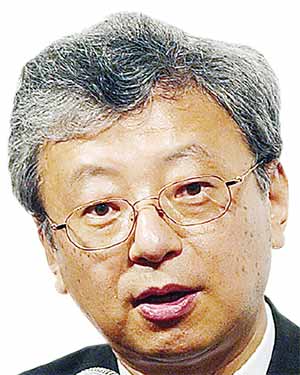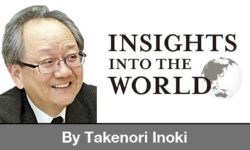11:00 JST, May 24, 2024
“The tide has turned.”
More and more people seem to believe this as they look at the current Japanese economy. Now that prices and wages in Japan have continued to rise steadily, a possible escape from more than 20 years of deflation has come into sight.
The trend away from deflation began with higher prices for imported goods. However, the impact of so-called import inflation was limited to certain industrial sectors that have no choice but to import raw materials from abroad. Theoretically speaking, price hikes rarely occur across an economy when there is no widespread increase in wages. Sustainable price growth becomes possible only after a virtuous cycle between prices and wages continues to strengthen, with higher prices leading to wage increases and then higher wages prompting further price uptrends.
The outcome of this year’s shunto spring wage negotiations heralded the start of a sustainable price-wage climb. The Bank of Japan raised interest rates as it became confident of such a positive trend.
Why does the beginning of price growth “turn the tide” in the economy?
Deflation has a slowdown effect on economic activity. So, when an economy can escape from deflation, it can break free from the negative effects of deflation. Deflation does not result from an economic slump, but it does prevent economic buoyancy.
Why exactly does deflation affect economic activity? If this point becomes clear, it will become possible to understand why inflation stimulates economic activity.
The most important factor is interest rates. For a few years until the novel coronavirus began spreading, the yield on the newly issued 10-year Japanese government bond, the benchmark for Japan’s long-term interest rates, remained at almost 0%, while its inflation rate also stayed near 0% over the same period. The long-term interest rate appears to have recently risen, as it has been hovering around 0.9%. But the story will be different when the latest inflation rate is taken into account.
Let’s use the so-called real interest rate, which is the value obtained by subtracting the price increase rate from the nominal interest rate. The pre-COVID-19 real interest rate was 0%. However, the recent inflation rate is in the upper 2% range, meaning that the real interest rate is now in the upper minus 1% level, which is below the level seen during the period of deflation.
When an economy is in the grips of deflation, prices do not rise and therefore the real interest rate does not fall. In contrast, during a period of inflation, the real interest rate drops sharply into negative territory.
The BOJ looks inclined to raise interest rates. In reality, however, the real interest rate has now fallen, as inflation has largely outpaced interest rates in terms of upward movements. As a result, the central bank is expected to maintain a monetary policy of keeping the nominal interest rate below inflation, which in turn will likely keep the real interest rate in negative territory.
In other words, Japan’s financial market conditions have eased thanks to price increases. As long as the real interest rate remains in negative territory, transactions in the stock, real estate and other asset markets will continue gathering momentum, stimulating the economy. This positive trend is expected to induce corporations to boost capital investment.
Wide interest rate gap
Interest rates greatly affect foreign exchange markets. Let’s look at the relationship between interest rates and foreign exchange rates.
Until around the beginning of 2021, the Japanese currency moved in a range of about ¥100 to about ¥120 to the U.S. dollar for years. However, the widening of the interest rate differentials between Japan and the United States has now resulted in a sharp fall in the yen’s value.
In the United States, consumer prices began rising sharply in the latter half of 2021 in the wake of the COVID-19 pandemic, compelling the U.S. Federal Reserve to raise its policy rate at breakneck speed in a bid to tame inflation. Over the course of 1½ years from early 2022, the U.S. policy rate rose from 0.25% to 5.5%.
Over the same period, Japan’s policy rate was left completely unchanged. In March this year, the BOJ finally ended its negative interest rate policy and raised the overnight rate by 0.1 point. Nonetheless, the interest rate gap between Japan and the United States is still significant.
International investment capital naturally flowed to the currency with the higher interest rate. Consequently, the yen briefly weakened to the 160 level against the dollar, while the greenback went up against almost all other currencies as well. The U.S. currency is thus alone in its appreciation.
The foreign exchange rate has two “faces.” The first shows the value of goods and services offered in each currency’s host country. In the case of the yen, the weaker it becomes against foreign currencies, the cheaper domestic prices become relative to foreign countries. The yen-dollar exchange rate, therefore, can be said to indicate the differentials of prices of goods and services between Japan and the United States.
When seen from this perspective, the current yen-dollar exchange rate is extremely biased towards yen depreciation. If the exchange rate reflected real economic trends, such as trade balance and international balance of payment data, it would not have been strange if the yen had headed a little higher against the dollar.
The other face of the foreign exchange rate is asset valuation. This aspect currently comes to the fore as a stronger exchange rate determinant.
In this regard, the yen-dollar exchange rate also indicates the differentials between yen-denominated and dollar-denominated assets. So, the weaker the yen is versus the dollar, the cheaper the yen-based assets become relative to the dollar-based assets. This is where we are now. When seen from abroad, Japanese stocks and assets are very cheap.
When the exchange rate functions as the benchmark for exhibiting asset prices, it fluctuates, reflecting the levels of supply and demand for assets. In a situation like the current one where greater interest rate differentials exist between Japan and the United States, funds flow to the dollar because the United States offers higher interest rates, buoying the dollar — and lowering the yen — sharply. Put differently, the interest rate differentials between Japan and the United States are so large that supply and demand for assets cannot be balanced unless the yen is allowed to sink to a great extent.
What has been happening in the foreign exchange markets must look unreasonable to corporations that engage in trade and other real economic activities. Some people are calling for foreign exchange market intervention to rectify the excessive weakness of the yen.
Monetary policy’s capacity
However, it should be noted that as money globalizes and crosses borders instantly, the foreign exchange rate is set to act even more as a gauge of asset prices, shrinking the impact of trade and other real economic activities on the foreign exchange markets.
Given the existing large interest rate differentials between Japan and the United States, it seems unlikely that we will see a large-scale correction to the depreciation of the yen. Moreover, market intervention by the Japanese government and the BOJ is likely to have only limited effects on the yen’s rate because their resources for intervention are constrained.
It is monetary policy that has the capacity to redress the yen’s excessive weakness. Should Japan’s interest rates rise and U.S. interest rates drop, narrowing the interest rate differentials between the two economies, the yen would strengthen and the dollar would weaken.
To avoid my being misunderstood, I need to say that I am not calling for the deployment of monetary policy exclusively to change the exchange rate. I mean that Japanese-U.S. interest rate differentials might narrow as a result of appropriate monetary policy implementation in Japan and the United States in dealing with their respective price movements.
In the United States, as inflation has not yet come under control, the Federal Reserve has not been able to lower its benchmark interest rate. Even so, as the Fed keeps interest rates high, such a stance is likely to prevent the U.S. economy from overheating and send prices lower. In the end, the U.S. central bank will be able to reduce its policy rate.
Here in Japan, once price increases spread across the economy, the BOJ will be able to raise its policy rate further.
The excessive depreciation of the yen we are now witnessing can be defined as a phenomenon caused by the gap between the U.S. and Japanese situations — the United States’ inflation that has barely come down yet and the absence of U.S.-style inflation in Japan.

Motoshige Itoh
Itoh is a professor emeritus at the University of Tokyo. He also served as a professor with the Faculty of International Social Sciences at Gakushuin University until March 2022.
The original article in Japanese appeared in the May 20 issue of The Yomiuri Shimbun.
"Editorial & Columns" POPULAR ARTICLE
-

Violations of Subcontract Law: Major Automakers Must Eliminate Old Practices
-

Local Governments’ Tax Revenues: Devise Ways to Correct Imbalances in Tax Sources
-

5 Japanese Business Dinner Mistakes to Avoid — and What They Taught Me About Business in Japan
-

Heavy Rains in Asia: Support for Victims, Flood-Control Measures Urgently Needed
-

New Nuclear Threat: China Seeking to Follow U.S., Russia in Military Expansion
JN ACCESS RANKING
-

Keidanren Chairman Yoshinobu Tsutsui Visits Kashiwazaki-Kariwa Nuclear Power Plant; Inspects New Emergency Safety System
-

Imports of Rare Earths from China Facing Delays, May Be Caused by Deterioration of Japan-China Relations
-

University of Tokyo Professor Discusses Japanese Economic Security in Interview Ahead of Forum
-

Japan Pulls out of Vietnam Nuclear Project, Complicating Hanoi’s Power Plans
-

Govt Aims to Expand NISA Program Lineup, Abolish Age Restriction

























